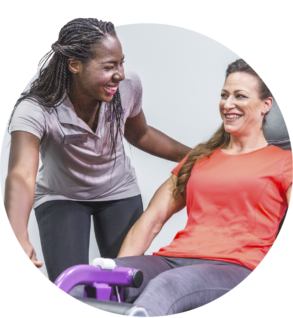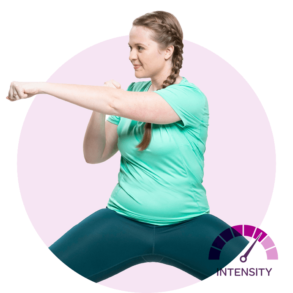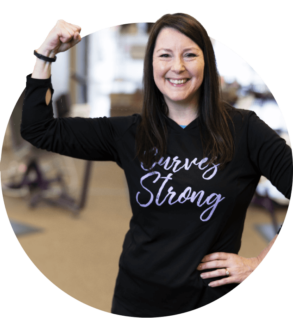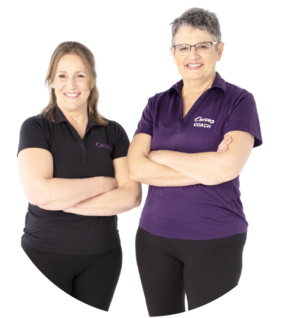Relieve Neck and Shoulder Pain with Foam Rolling
Any woman who regularly engages in the Curves Circuit or other strength-focused full-body workouts knows that exercise comes with occasional soreness and muscle pain. Sometimes that soreness comes from the muscle “damage” from a tough workout that causes muscles to grow stronger and more toned. Other times, it is from a strain or injury. Either way, if the pain is in your neck and shoulders, it is impossible to ignore. Each time you move your arms or head, you are reminded of the discomfort. The good news is you do not have to spend tons of money and time on professional massages for your shoulder or neck pain. Once you have the green light from your doctor, you can use effective foam rolling exercises to relieve neck and shoulder pain.
What is a foam roller?
Foam rollers are cylinders made from solid foam that come in assorted sizes and levels of firmness. By placing the foam roller under your body and moving in particular ways, stress, tension, and pain can be relieved through a technique called self-myofascial release (SMR). Foam rolling works to relieve muscle pain by increasing blood flow to the muscles and breaking up knots, or trigger points. 2
People use foam rollers for a variety of reasons. Some roll out their muscles to loosen them up before a full-body workout. Others use them post-workout to prevent soreness. And foam rollers can also be used to get rid of muscle tension, either post workout or whenever it may strike. 1
Studies have shown foam rolling has merit. One study found that people who used foam rollers for three days in a row had less muscle fatigue and better range of motion. So, it seems foam rolling benefits accumulate over time.3
Here are some additional foam roller benefits:
- Foam rolling promotes healing. When you use a foam roller on your neck and shoulders, it compresses the tissues and increases blood flow. This carries nutrients and oxygen to those tissues, which breaks up knots and promotes healing.
- It helps tissues move. When you use a foam roller to relieve neck pain or decrease shoulder tightness, it makes the tissues softer and more pliable. This reduces the force on the joints and helps muscles move the way they were intended to.
- You can do it on your own. When neck and shoulder pain strikes, you don’t have to ask a friend or family member for a massage or go to a professional; you can use a foam roller to relieve neck and shoulder pain on your own. And because you can do it yourself, you will be more likely to perform foam rolling regularly and consistently, which will lead to better mobility, less shoulder and neck pain, and better muscle function overall.4
To gain these foam roller benefits, here are some of the most effective foam roller stretches:
Thoracic spine release
To perform this stretch, sit on the floor with your knees bent and your feet flat on the floor. Place the foam roller behind you. Lean back on the foam roller so that each vertebra is in contact with the roller. Keep your chin tucked, as if you were holding an egg under it. Engaging your core, lift your arms directly above your shoulders reaching your hands towards the ceiling. This movement will separate your shoulder blades. Use controlled movements to lower your arms out to your sides, forming a snow angle. Perform one to two sets before or after your full body workout.5
Latissimus dorsi roll
To foam roll your latissimus dorsi, or lats, lie on one side with the foam roller under your armpit. Using your forearms for support, move on the foam roller along the length of the entire muscle about one inch per second until you hit the most tender spot. Hold the pressure on that spot for 30-90 seconds. Be sure to breathe as you hold pressure. Repeat on the opposite side. Do two sets.6
Pectoral roll
Lying in the prone position, place the foam roller at the base of your pec near your armpit. Support yourself with your free hands and feet and slowly roll up and down the length of your pec for 20 to 30 seconds. Adjust pressure on the roller by raising your hips higher or lower or putting more force on your free hand on the ground. Be sure to breathe as you hold pressure. Repeat on the other side.7
Suboccipital stretch
Lie on your back with your knees bent and your feet flat on the floor. Place the foam roller under your neck so it’s just at the base of your skull. Slowly nod your head up and down, and then turn your head left and right, to relieve tension. 8
Keep in mind that foam rolling may cause slight discomfort or pain as it breaks apart muscle knots, but you should not feel sharp, severe pain. If you feel this type of pain while you are using a foam roller, stop immediately.
It is also important to realize that foam rolling, and other forms of myofascial release can cause discomfort and could aggravate existing medical issues. So, it’s important to use the correct techniques and distinguish between discomfort and pain. To learn more about using your Curves foam roller to relieve neck and shoulder pain, ask your Curves Coach on how to gain access to our Foam Rolling classes on MyCurves On Demand.
Sources:
- Tight muscles? Try a foam roller (webmd.com)
- Using a Foam Roller to Relieve Neck Pain (chiroboston.com)
- The Effect of Foam Rolling for Three Consecutive Days on Muscular Efficiency and Range of Motion – PMC (nih.gov)
- How to use a foam roller to relieve neck, back and knee pain (nbcnews.com)
- How to Foam Roll Your Thoracic Spine With Perfect Form – 2023 – MasterClass
- How to Foam Roll Latissimus Dorsi | NASM
- How to Foam Roll Your Chest Muscles – 2023 – MasterClass
- How to Use a Foam Roller for Neck Tension – Steel Supplements








